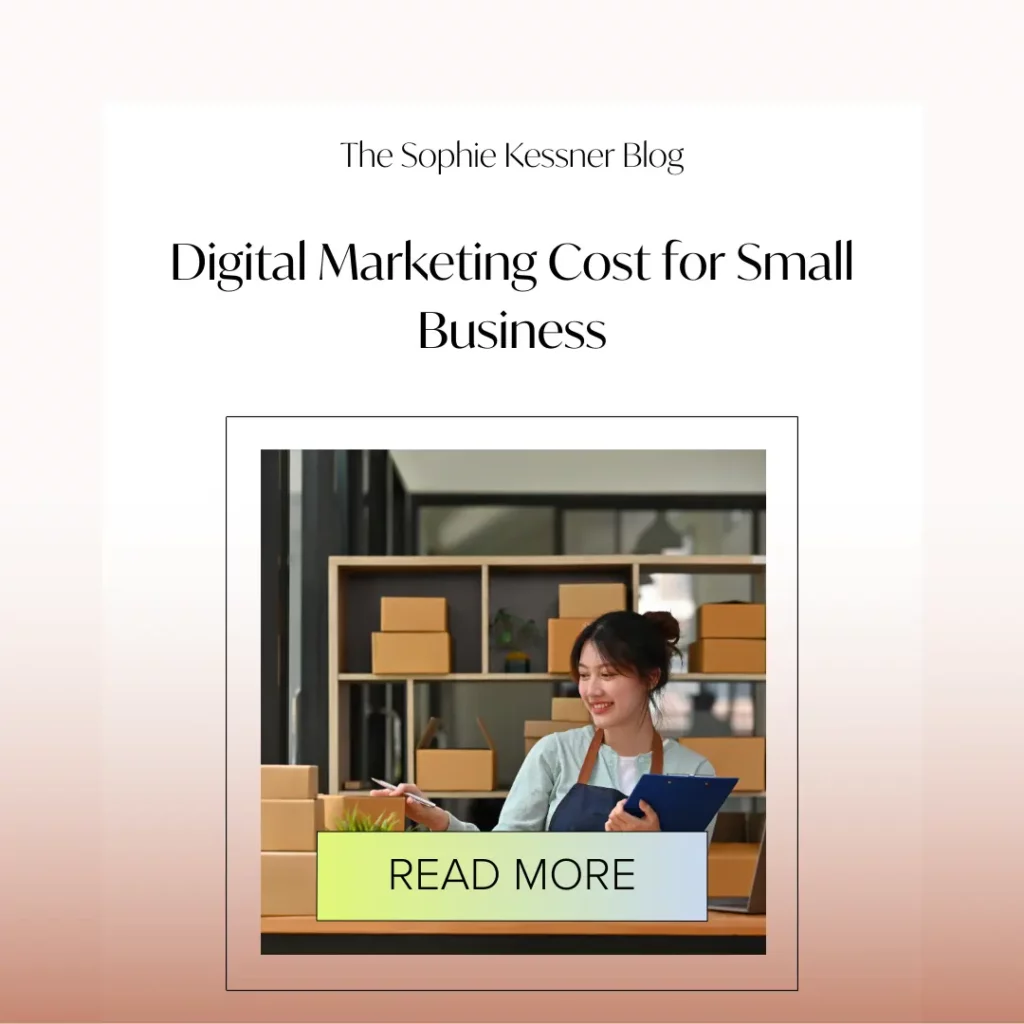Small businesses face unique challenges when investing in digital marketing-balancing limited budgets with the need for growth. This comprehensive guide examines exactly what small businesses should expect to pay for digital marketing in 2025, analyzing real costs across all major channels, including advertising costs associated with pay-per-click (PPC) advertising and its variable pricing structure.
The cost of digital marketing depends on several factors, such as business size, industry, target audience, and chosen channels. Whether you’re allocating your first marketing budget or optimizing existing spend, you’ll discover industry benchmarks, cost-saving strategies, and ROI measurement techniques specifically designed for small business constraints. Recent data shows companies spend an average of 8.7% of revenue to marketing, with small businesses spending $5,000-$15,000 monthly and directing 57.9% toward digital channels.
By understanding true costs and implementing strategic approaches outlined here, you’ll maximize every marketing dollar while competing effectively against larger competitors with deeper pockets.
Digital Marketing Investment Snapshot for Small Businesses in 2025
Before you set your marketing budget, it helps to know what other small businesses are spending and where that money goes—including how much is allocated to paid advertising. Here’s a quick look at the digital marketing landscape for small businesses in 2025:
Average Spend by Industry:
Depending on your industry, monthly digital marketing costs can vary widely. Retail and e-commerce businesses often spend more on ads, while service-based businesses may invest more in SEO and content marketing. Social media marketing costs typically range from $100 to $5,000 per month, depending on factors such as the number of social networks used and the depth of campaign management. These costs can lead to significant benefits, including increased online presence, brand awareness, and revenue.
Percentage of Revenue:
On average, small businesses spend about 7.7% of their revenue on marketing. This includes both digital and traditional channels, but digital usually gets the bigger share. According to the U.S. Small Business Administration, the recommended percentage for marketing budgets varies based on business size and sector, with small businesses advised to allocate a certain percentage of their revenue for effective marketing.
Monthly Budget Range:
Most small businesses allocate between $5,000 and $15,000 per month for marketing. If you’re just starting out, your budget might be lower, but these numbers give a good benchmark.
Digital marketing packages offer various service offerings that agencies provide, outlining their pricing structures and emphasizing the strategic value of these packages in achieving a seamless customer journey.
Digital vs. Traditional:
Around 58% of marketing budgets now go toward digital channels like social media, search ads, and email marketing. The rest is spent on offline methods like print or events. Traditional marketing methods are declining in budget allocation, while digital methods produce higher ROI and lead generation at a lower cost.
Cost vs. ROI:
Digital marketing costs can range from as low as $50 a month for basic tools to over $6,000 for full-service campaigns. The key is to focus on channels that deliver the best return on investment for your business. Evaluating the digital marketing worth involves considering benefits such as increased brand awareness, lead generation, and measurable ROI, arguing that when aligned with business objectives, digital marketing can lead to significant financial returns.
Trends Impacting Costs:
Automation tools, AI-powered ads, and evolving algorithms are shaping pricing and how businesses spend their marketing dollars in 2025.
Knowing these numbers helps you set realistic expectations and build a budget that fits your business size and goals. In the next section, we’ll break down costs by specific digital marketing channels so you can plan smarter. Flexibility and informed decision-making in budgeting and performance review are crucial to ensure that marketing investments contribute to long-term success and online visibility, leading to sustainable growth.
Factors Affecting Digital Marketing Cost

Several factors influence digital marketing costs, including business size and scope, target market and audience, marketing channels used, and the level of expertise required. Larger businesses often require more extensive digital marketing strategies, which can be more costly. The target market and audience also play a significant role in determining digital marketing costs, as reaching a wider or more diverse audience can be more expensive. Additionally, the choice of marketing channels, such as social media marketing or PPC advertising, can impact costs. Understanding these factors is crucial for businesses to estimate their digital marketing costs and allocate their marketing budgets effectively.
Comprehensive Digital Marketing Pricing Guide for Small Businesses
Understanding the costs behind each digital marketing channel can help you decide where to spend your budget for the best results. Let’s break down the typical prices you can expect in 2025 for the main digital marketing services small businesses use.
Search Engine Optimization (SEO)
SEO helps your website show up in Google search results, bringing in free, organic traffic over time. For small businesses, SEO costs usually fall into these ranges:
Basic SEO packages: $500 to $2,500 per month. These usually include keyword research, on-page optimization, and some content updates.
Full-service SEO: $2,500 to $7,500 per month. This covers more in-depth work like link building, technical SEO fixes, and ongoing content creation.
Local SEO: Often cheaper, around $300 to $1,500 monthly, focusing on local listings and maps.
The cost of digital marketing through SEO varies widely. Factors that affect SEO pricing include how competitive your industry is, how many keywords you want to target, and whether you need new content created. Targeting highly competitive keywords can significantly increase pricing, as it requires more advanced strategies and sustained effort to achieve strong rankings.
You can save money by handling some content writing yourself or focusing on local SEO if your business serves a specific area. SEO is a core digital marketing service essential for driving consumer engagement and enhancing online visibility.
Pay-Per-Click (PPC) & Search Ads
PPC ads let you pay for clicks on platforms like Google Ads or Bing Ads. As a core component of digital advertising, PPC offers small businesses a flexible way to reach their audience. Here’s what small businesses should expect:
Average cost-per-click (CPC): Varies by industry but usually ranges from $1 to $5 for most small business keywords.
Minimum monthly ad spend: To see meaningful results, plan on spending at least $1,000 to $3,000 per month on ad budget.
Management fees: Agencies or freelancers typically charge 10% to 20% of your ad spend to manage campaigns.
Platform choices: Google Ads is the most popular, but Bing Ads can be cheaper with less competition. Social media PPC (Facebook, Instagram) also offers targeted options.
Pay-per-click advertising is an effective way to quickly drive traffic and target specific demographics, making it a valuable part of a broader marketing campaign.
To get the most from PPC on a small budget, focus on tightly targeted campaigns, pause underperforming ads, and test different keywords regularly.
Social Media Marketing
Social media marketing includes both organic posting and paid ads on social media platforms like Facebook, Instagram, LinkedIn, and TikTok.
Management and content creation: Hiring someone to manage your social media can cost $400 to $2,000 per month depending on how many platforms and posts you want.
Ad spend: Small businesses often spend $500 to $3,000 monthly on social media ads.
Organic vs. paid: Organic growth takes time and effort but costs less. Paid ads speed up results but require a budget.
Incorporating video marketing—such as short-form videos, reels, or live sessions—can significantly boost engagement on many social media platforms. Mixing organic content with paid ads usually works best. If you’re tight on budget, focus on the platform where your customers spend the most time.
Employing a dedicated social media manager can enhance the effectiveness of campaigns through comprehensive services, including content creation, analytics, and strategic planning.
Content & Email Marketing
Content marketing builds trust and attracts customers through blogs, videos, and emails.
Content creation: Blog posts or videos can cost $100 to $500 each depending on length and quality.
Email marketing tools: Platforms like Mailchimp or Constant Contact charge $10 to $300 per month based on your list size.
Automation setup: Setting up automated email sequences can cost $500 to $2,000 if you hire help.
Content marketing often works best when integrated with various digital marketing services, such as SEO, social media, and paid advertising, to create a cohesive strategy. You can save money by writing your own blog posts or emails, but professional content often gets better results. Email marketing remains one of the most cost-effective ways to nurture leads and boost sales. Different campaign requirements can influence the costs of email marketing services, ranging from basic platforms suitable for small businesses to comprehensive solutions tailored for larger campaigns.
Website & Conversion Optimization
Your website is the foundation of your digital marketing. Here’s what to expect:
Maintenance: $100 to $500 per month for updates, security, and backups.
Conversion optimization: Investing $500 to $2,000 for A/B testing, improving user experience, and faster loading times can boost sales.
One-time redesigns: Can cost $2,000 to $10,000 depending on complexity.
Small improvements to your website can make a big difference in turning visitors into customers, so don’t skip this part. Web design plays a crucial role in influencing your business’s online presence, and ongoing website maintenance is necessary following the initial investment.
Knowing these costs helps you plan a budget that fits your business needs. Next, we’ll look at how to create a marketing budget step-by-step.
Marketing Strategy Development
Developing a marketing strategy is essential for businesses to achieve their objectives and maximize their return on investment (ROI). A well-planned marketing strategy should align with business goals and target audience needs. Digital marketing agencies can help businesses develop a customized marketing strategy, taking into account their unique needs and objectives. The strategy should include a mix of digital marketing channels, such as SEO, social media marketing, and email marketing, to reach and engage with the target audience. By developing a comprehensive marketing strategy, businesses can ensure that their digital marketing efforts are effective and efficient.
Creating Your Small Business Digital Marketing Budget

Setting up a digital marketing budget doesn’t have to be overwhelming. Here’s a simple way to build one that fits your business and goals while making the most of your marketing spend:
1. Look at Your Revenue
Start by checking your yearly revenue. Small businesses usually spend about 8-10% of their revenue on marketing. For example, if your revenue is $300,000, your marketing budget might be around $24,000 to $30,000 a year.
2. Define Your Goals
What do you want from your marketing? More website visitors, leads, sales, or brand awareness? Clear goals help you decide where to spend your money.
3. Pick Your Channels
Choose the digital marketing channels that best match your goals and audience. This could be SEO, social media, PPC ads, email marketing, or content creation.
4. Divide Your Budget
Split your budget across these channels. For example, you might allocate 40% to PPC ads, 30% to SEO, and 30% to social media marketing.
5. Set Aside Money for Testing
Reserve about 10-15% of your budget for testing new campaigns or tools. Testing helps you find what works without risking too much.
6. Adjust for Seasonality
If your business has busy and slow seasons, plan to spend more during peak times and less when things slow down.
7. Track and Review
Regularly check how your marketing is performing. If something isn’t working, don’t be afraid to shift your budget to better-performing areas.
Quick Tip: Use a simple spreadsheet or free budgeting tools to keep track of your spending and results. This makes it easier to stay on top of your budget and make smart decisions.
By following these steps, you can create a marketing budget that’s realistic, flexible, and focused on helping your business grow. When planning your small business marketing budget, consider whether you will hire an agency, bring in an in-house team, or opt for a DIY approach, as this choice significantly impacts the overall costs.
Digital Marketing Tools
Various digital marketing tools are available to help businesses manage and optimize their digital marketing efforts. These tools include social media management platforms, email marketing software, and SEO analytics tools. By leveraging these tools, businesses can streamline their digital marketing processes, track their performance, and make data-driven decisions. Additionally, digital marketing agencies can provide businesses with access to these tools and expertise in using them effectively. Some popular digital marketing tools include Google Ads, Facebook Ads, and Hootsuite, among others.
Cost-Saving Strategies: Do More With Less
Marketing on a tight budget doesn’t mean you have to miss out on results. Here are some smart ways to stretch your marketing dollars:
Use DIY Tools: Platforms like Canva for design, Mailchimp for email, and Google Ads’ built-in tools let you handle many tasks yourself without extra costs.
Hire Freelancers for Specific Tasks: Instead of a full-service agency, consider freelancers for writing, graphic design, or ad management. This often costs less and gives you flexibility.
Repurpose Your Content: Turn one blog post into social media posts, email newsletters, or videos. This saves time and money while reaching more people.
Focus on High-Return Channels: If PPC ads or email marketing bring the most leads, put more budget there and cut back on less effective channels.
Automate Repetitive Tasks: Use email automation and social media schedulers to save time and keep your marketing consistent.
Leverage Free Marketing: Engage with customers on social media, ask for reviews, or join local business groups. These cost little but build trust and awareness.
Negotiate with Providers: Don’t hesitate to ask agencies or freelancers for discounts or flexible payment plans, especially if you’re starting out.
Remember, spending smart beats spending big. Focus on what works best for your business and cut anything that doesn’t bring value. Additionally, consider the benefits and expenses associated with hiring an agency versus utilizing an in-house team, as each option has distinct advantages and can complement each other in achieving your marketing goals.
Red Flags: How to Know If You're Paying Too Much

It’s easy to spend more than you need if you don’t know what fair pricing looks like. Watch out for these warning signs:
Unclear Pricing: If an agency or freelancer can’t clearly explain what you’re paying for, be cautious. You should understand exactly what services are included.
Hidden Fees: Look out for extra charges like setup fees, monthly reporting fees, or cancellation penalties that aren’t mentioned upfront.
Promises That Sound Too Good: Be skeptical of guarantees like “#1 ranking on Google” or “double your sales in 30 days.” No one can promise exact results.
High Upfront Costs: Avoid paying large sums before seeing any progress or results. A reasonable deposit is normal, but most payments should be tied to deliverables.
Lack of Transparency: If you don’t get regular reports or updates, you might be paying for work you can’t verify.
One-Size-Fits-All Packages: Your business is unique. Be cautious if you’re offered a generic plan that doesn’t fit your goals or industry.
Pressure to Sign Quickly: Good agencies give you time to ask questions and decide. If someone pushes you to sign fast, that’s a red flag.
Always ask for references or case studies to check past performance. Comparing multiple quotes helps you spot overpriced offers. Trust your instincts—if something feels off, look elsewhere. An experienced digital marketing agency will provide clear communication, tailored strategies, and measurable results. Each type of digital marketing service, such as SEO, PPC, and social media marketing, has its own pricing structure, which significantly drives costs.
Pricing Models and Contract Structures Explained
Understanding how pricing works can help you choose the right marketing partner or approach for your small business. Here are the common pricing models and contract types you’ll encounter:
Retainer Model: You pay a fixed monthly fee for ongoing services like SEO, social media management, or ads. This gives steady support but often requires a longer commitment. Make sure the contract terms are clear before signing.
Project-Based Pricing: You pay for specific campaigns or projects, such as a website redesign or a one-time ad campaign. This is flexible but can add up if you need frequent work. A project-based pricing model assigns a fixed price to a specific project, providing clarity on costs before the work begins, making it effective for one-off projects that have clear goals and timelines.
Performance-Based Pricing: You pay based on results, like the number of leads or sales generated. This lowers your risk but may limit the scope of work or creativity from the provider.
Hourly Rates: Freelancers or consultants might charge by the hour, typically between $50 and $150. This is good for small tasks or short-term help.
Month-to-Month vs. Long-Term Contracts: Month-to-month contracts offer flexibility to stop or change services anytime, but long-term contracts often come with discounts or extra perks.
Before you sign any agreement, read the contract carefully. Look for details on deliverables, reporting frequency, cancellation policies, and payment terms. Clear contracts help avoid surprises and keep your marketing on track.
DIY vs. Agency vs. Freelancer: Cost-Benefit Analysis

When it comes to handling your digital marketing, you have three main options: do it yourself (DIY), hire a freelancer, or work with an agency. Each choice has its pros and cons, depending on your budget, time, and goals.
DIY Marketing: This is the cheapest option since you’re doing the work yourself. It’s great if you have time to learn and manage campaigns. However, it can take a while to get results, and there’s a learning curve. DIY works well for simple tasks like social media posting or email newsletters, but may fall short for more complex marketing tactics like advanced SEO or paid advertising.
Freelancers: Hiring freelancers usually costs more than DIY but less than agencies. Freelancers often specialize in specific areas like content writing, graphic design, or ad management. They offer flexibility and can handle tasks you don’t want to do. Keep in mind, freelancers may have limited availability.
Agencies: Agencies are the most expensive option but provide full-service marketing support. They have teams of experts who can handle everything from strategy to execution. Agencies are ideal if you want faster results and don’t have time to manage marketing yourself. However, they often require longer contracts and bigger budgets. A digital marketing agency can help businesses enhance their online visibility and achieve measurable results by leveraging their expertise and experience.
Things to consider:
Time: DIY takes the most time; agencies save you time but cost more.
Expertise: Agencies and freelancers bring more experience; DIY may require learning new skills.
Scalability: Agencies can scale campaigns quickly; freelancers may have capacity limits.
Quality: Agencies usually deliver higher quality work but at a premium price.
Many small businesses find success by mixing these options-doing some tasks themselves, hiring freelancers for specialized work, and using agencies for big projects. This approach helps control costs while getting expert help where it counts.
Measuring Marketing ROI and Optimizing Spend

Knowing how well your marketing dollars are working is key to making smart decisions. Here’s how to measure your marketing ROI and get the most from your budget:
Set Clear Goals and KPIs:
Decide what success looks like for your business. Common goals include increasing website visits, generating leads, boosting sales, or growing social media followers. KPIs (key performance indicators) help you track progress toward these goals.
Use Simple Tracking Tools:
Tools like Google Analytics, Facebook Insights, and email platform reports give you easy access to data without needing technical skills. These tools show how many people visit your site, click your ads, or open your emails.
Compare Costs to Results:
Look at how much you spend on each channel versus the leads or sales it brings in. This helps you see which channels give you the best return.
Understand Attribution:
Sometimes, customers interact with multiple marketing channels before buying. While advanced attribution tools exist, start simple by tracking the first and last touchpoints to understand what’s driving sales.
Review Regularly:
Check your marketing performance monthly or quarterly. If a campaign isn’t delivering, adjust or pause it to avoid wasting money.
Test and Learn:
Run small tests with different ads, keywords, or content to find what works best. Testing helps you improve results and avoid spending on ineffective tactics.
Shift Your Budget:
Move money toward channels and campaigns that perform well. Don’t be afraid to cut back on what isn’t working.
Keep in mind that some marketing efforts, like SEO, take time to show results. Be patient but stay consistent with tracking and optimizing.
By measuring ROI and adjusting your spend, you make sure every dollar counts and your marketing grows your business efficiently. Additionally, aligning budget considerations with achieving marketing goals in digital marketing and content creation ensures that your investments are strategic and lead to long-term success.
Digital Marketing Best Practices
To ensure the effectiveness of digital marketing efforts, businesses should follow best practices, such as setting clear objectives, targeting the right audience, and measuring performance. Additionally, businesses should stay up-to-date with the latest digital marketing trends and algorithm updates to ensure that their strategies remain effective. Some best practices include optimizing website content for SEO, using social media advertising to reach target audiences, and leveraging email marketing to nurture leads. If your business serves a specific local community, consider tailoring your digital marketing strategies to engage with local customers effectively. By following these best practices, businesses can maximize their digital marketing ROI and achieve their objectives.
Conclusion: Your 2025 Digital Marketing Roadmap
Digital marketing doesn’t have to be confusing or expensive. By understanding typical costs and planning your budget wisely, you can grow your small business without wasting money. Start by setting clear goals and choosing the right channels for your audience. Use the cost ranges we covered to create a budget that fits your business size and needs.
If you’re ready to take control, our DIY SEO course is a great place to start. It’s designed to teach you how to improve your website’s search rankings step-by-step, saving you money and giving you more confidence. For those who prefer a hands-off approach, Sass and SEO also offers full-service SEO agency support to handle everything from strategy to execution.
The key is to set clear goals, pick the right channels, and track your results regularly. Use the cost ranges and tips in this guide to create a budget that fits your business size and goals. Smart spending and consistent effort will help your business grow and compete in 2025. A comprehensive digital marketing strategy is a critical component for businesses to maintain competitiveness in the market.
Whether you choose DIY learning or professional help, Sass and SEO is here to support your journey. Start today, and watch your business reach more customers and sales.
Frequently Asked Questions (FAQs)
How much should a small business spend on digital marketing?
Most small businesses spend between 8-10% of their revenue on marketing. For digital marketing alone, budgets often range from $5,000 to $15,000 per month depending on goals and industry.
How much does digital marketing cost?
The costs associated with digital marketing can vary widely. Pricing structures include hourly rates, monthly retainers, and project-based fees. On average, businesses might spend anywhere from $2,500 to $12,000 per month. Factors such as the complexity of the strategy, the number of channels used, and the specific goals of the business can significantly influence the overall expenses.
What’s the cheapest digital marketing channel?
Email marketing and organic social media are usually the most affordable. SEO can also be cost-effective long term, but it takes time to see results.
Should I hire an agency or do marketing myself?
If you have time and want to save money, DIY can work. For faster results or complex campaigns, freelancers or agencies bring expertise but cost more.
How do I know if my marketing budget is working?
Track key metrics like website visits, leads, and sales. Compare these to your spend regularly and adjust your budget toward the best-performing channels.
Can I start digital marketing with a small budget?
Yes! Focus on high-ROI channels like local SEO or targeted social ads. Use free tools and create your own content to stretch your budget further.





